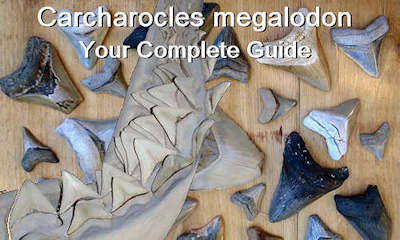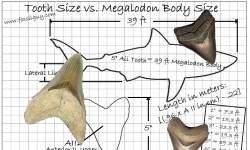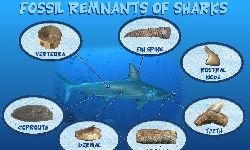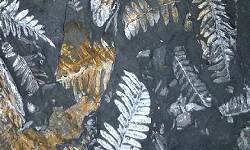Shark Teeth Colors
Modern shark teeth are white; recent shark teeth have white roots and white enamel. So why are fossil shark teeth different colors? In fact why do fossils come in many different colors?
Colors of Shark Teeth: The Simple Answer
The color of a shark tooth, or any other fossil, is determined by the type of sediment the fossil is preserved in.
The color has almost nothing to do with the age or type of fossil.
To elaborate, let's take a basic look at the fossilization process for shark teeth:
Let's say a particular shark tooth is shed and sinks to the bottom of the sea. To become a fossil,
it is quickly buried by sediments. Over time, the oxygen poor sediment layers build up and up.
Pressure will start to compact the sediments that the shark tooth is entombed in. When enough layers
and pressure build up, water will cause minerals in the surrounding sediment to flow into the shark tooth
(permineralization). Eventually the minerals will fill in and replace most of the original organic material and the
shark tooth will become preserved as a fossil. The color of the minerals in the sediment will become the color of the fossil.

A Megalodon shark tooth found, still in the rock it fossilized in. The rock is a light gray limestone. Notice the tooth is also the same color. Found at Aurora, North Carolina.
Colors of Shark Teeth: Complicating Factors: A Slightly More Detailed Answer
Now, if you have fossil hunted for shark teeth and other fossils for a while, you will quickly question the above explanation. For example, the roots are sometimes completely different colors than the enamel. Sometimes blue/green teeth are found in gray sediments, white teeth can be found in brown sediments. Some shark teeth look polka dotted, and others have weird colored streaks in them. Obviously, more is going on than in the simple explanation above. Let's go into a little more detail:
Roots vs Enamel - Why are shark teeth roots and enamel often different colors?
Shark teeth enamel are made of a completely different substance than roots and bones, so they have a very different chemical composition. The difference in chemical composition makes them react differently to mineralization, which causes the differences in color.
Why are all the fossils in a certain formation or even the same layer not the same color?
Sometimes, like in Aurora, you can look in a light gray layer and find yellow/green teeth. Why they are not all the same color as the layer?
It's all in the chemistry. The exact types of sediments react differently to the fossils.
Clays are different than sands and silts, which are different than limestone. The properties of a sediment such as organic rich vs organic poor,
the PH balance (from acidic to basic), and even the size of the sediment grains, all react differently to the fossils. These different mineral
replacement reactions all affect the final outcome of the fossil color.
Post Fossilization:
Besides for the actual fossilization process, there are a multitude of other factors that can affect the color of a fossil after fossilization.
Ground Water:
If a fossilized shark tooth is in sediment has ground water running through, the water will leach the minerals back out of the fossil and cause color changes, making the colors lighter. Sometimes only part of the fossil is leached. In some cases, a fossil can look white again, like a modern tooth.
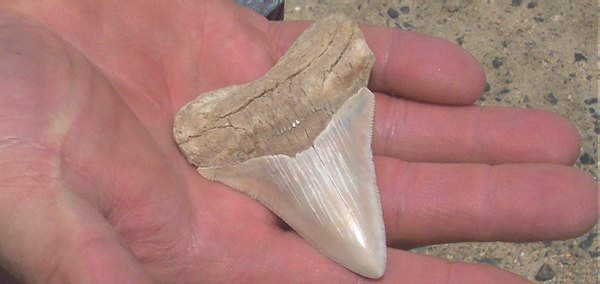
A white megalodon tooth. The color has been leached out of it by ground water
Other Anomalies:
There are a wide range of other post fossilization factors that can change the color of a fossil. For example, cracks in the sediment running along the fossil, plant roots and animal burrows against the fossil, and even different sized substrates other than the normal sediment lying against the fossil can change the color on parts of the fossil. These complicating factors, and others, can give the fossil a beautiful multicolored appearance; it can give them a cloudy, speckled, and even a streaked appearance.
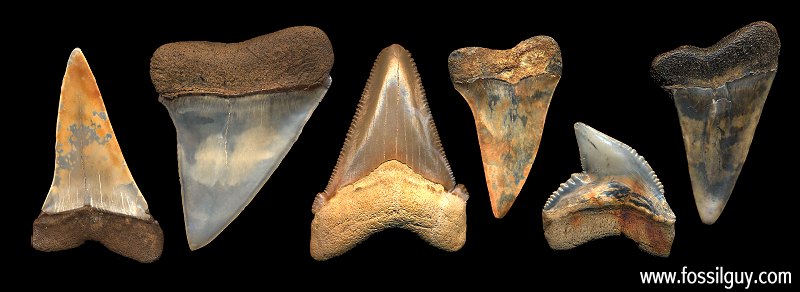
Notice the speckled and cloudy patterns on these teeth. The center orange angustidens tooth has a white lightning type pattern running up the right side of the root and enamel.
Examples of Shark Teeth Colors from Different Types of Sediments
Calvert Cliffs of Maryland
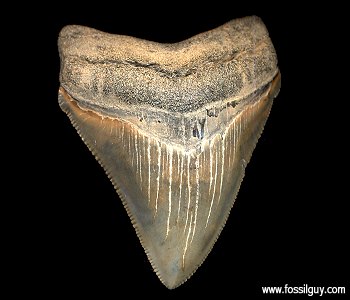
Many layers in the famous Calvert Cliffs consists of Bluish and Greenish clays, mixed with brown sands and iron. Fossils shark teeth from these layers tend to have a mix of these colors, with dabs of brown, blue, and green
Big Brook Area, New Jersey

The Cretaceous shark tooth bearing formations in New Jersey are full of iron oxide, or rust. This gives the shark teeth and other fossils a red / orange color.
Venice Beach, Florida
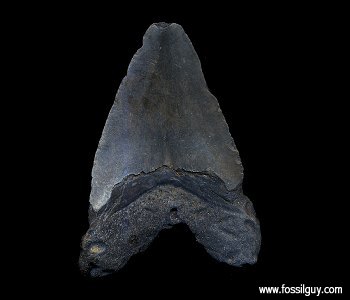
The Peace River formation in Florida is chalk full of phosphate, a dense, black mineral. The fossils here are often a black color. Venice Beach Collecting Area and the Peace River Collecting Area both have mainly black shark teeth due to the phosphate.
South Carolina
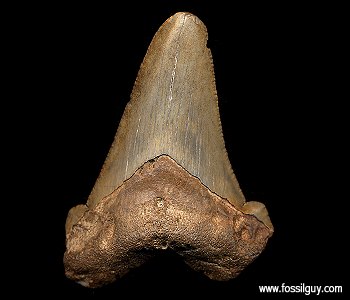
The coastal rivers in South Carolina contains tannins which give the rivers a characteristic dark brown color (Blackwater Rivers). Fossils from these rivers absorb the tannins and become dark brown color.
Aurora, North Carolina
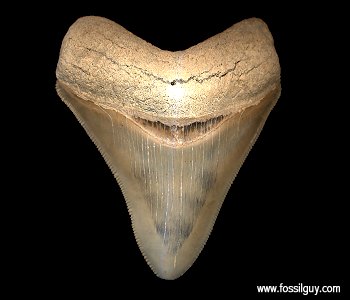
Fossils from the Pungo River Formation at Aurora, North Carolina have high concentrations of Phosphate preserving them. However, the limestones and other sedimentsare a gray color, giving the fossil shark teeth a beautiful grayish yellow collor.
Recommended Fossil Gear and Books
Get Your Very Own Megalodon Tooth:
These are Authentic Megalodon teeth sold by Fossil Era , a reputable fossil dealer (that I personally know) who turned his fossil passion into a business. His Megalodon teeth come in all sizes and prices, from small and inexpensive to large muesum quality teeth. Each tooth has a detailed descriptions and images that include its collecting location and formation. If you are looking for a megalodon tooth, browse through these selections!
Related Content
About the Author
Contact Us
To ask Questions about Paleontology, Fossil Identification, Image Use, or anything else, email us.
Fossilguy.com is very active on Facebook, you can also message us there!
We don't buy or sell fossils, so please don't email us asking about the value of a fossil or fossil purchases.
Visit us on Social Media:
Enjoy this website?
Consider a Paypal / Credit Card donation of any size to help with site maintenance and web hosting fees:
Privacy Policy and Legal Disclaimer
Back to the TOP of page
REWILD - Resotring Nature one Native Plant at a Time
© 2000 - 2025 : All rights reserved
Fossilguy.com is a participant in the Amazon Services LLC Associates Program, an affiliate advertising program designed to provide a means for sites to earn advertising
fees by advertising and linking to amazon.com







